Medieval Goldwork Embroidery Course
a journey through 500-years of embroidered history
You can check availability in my shop. Kits are added regularly!
What will you learn?
In this self-paced online Medieval Goldwork Embroidery Course, you will explore different forms of couching: underside couching, pattern couching, couching over padding and the queen of all couching techniques: or nué. You will explore each technique in its (art) historical setting. You will use as many authentic materials as possible for each of the eight samples. The beautiful goldwork techniques of the Middle Ages deserve precious gilt threads and natural silk!
By undertaking this Medieval Goldwork Embroidery Course, you will master the intricate process of creating medieval goldwork embroideries. You will gain insight into the technical inventions that revolutionised the process and the workshop setup. What inspired the stylistic language? You will uncover the close relationships between embroiderers, goldsmiths, painters and sculptors. Who were these embroiderers? Did they see themselves as artists? How were they organised? Who did they work for?
The core of the Medieval Goldwork Embroidery Course forms the eight embroidery samples you will work on. They are all inspired by actual medieval embroideries. You will handle luxury fabrics like samite and silk twill, as well as high-quality gilt threads and beautiful silk yarn. After taking this course, you will know the benefits of using madder, sienna paint and iron gall ink. This course is directed at embroiderers beyond the level of absolute beginner. With the possible exception of or nué, none of the techniques are (technically) difficult. The techniques covered form the basis for all my historical goldwork embroidery courses.
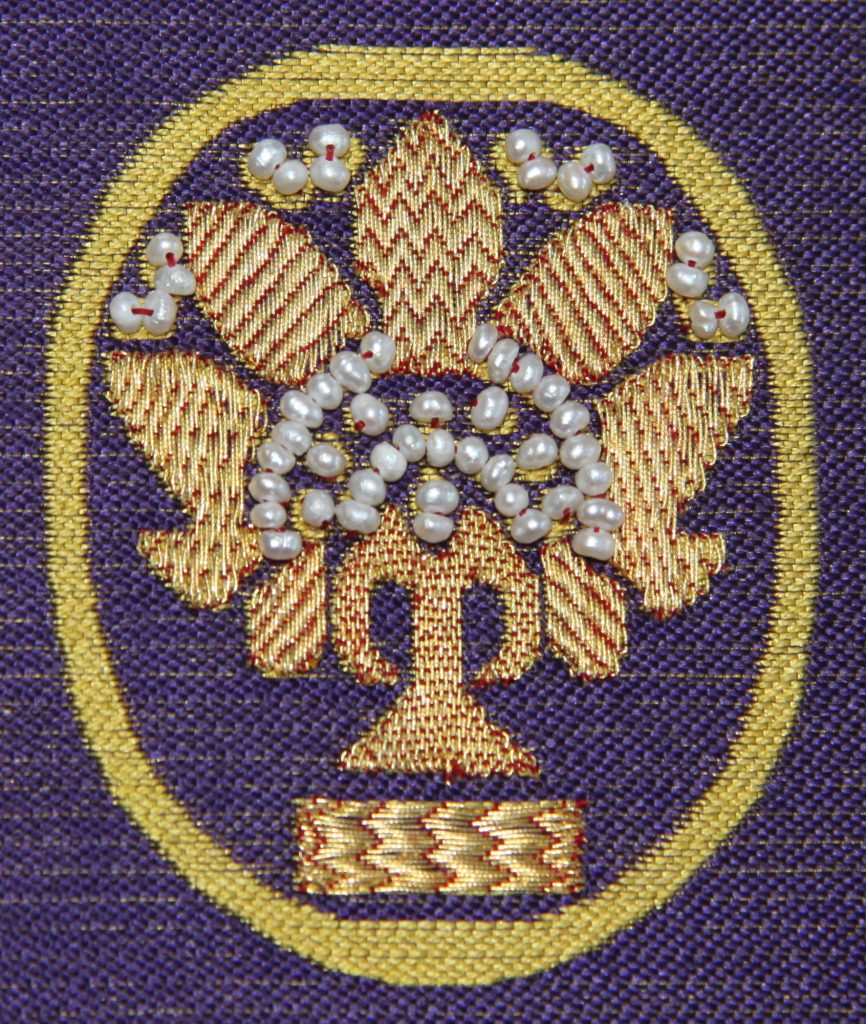
Lesson 1
After setting up your slate frame with 48 ct even weave linen, you will start stitching the first sample on silk samite. Samite was the fabric of choice for Europe’s oldest surviving gold embroideries. These were made around the year AD 1000. It is a super-luxurious fabric that is hard to come by nowadays.
The stitching consists of couching down a single thread of passing thread with a silken sewing thread. The sample measures c. 15 x 15 cm and is further embellished with cultivated freshwater pearls. Many medieval pieces had pearls on them originally. As these were easy to re-use, most pieces have lost part of their original splendour.
Lecture Video: 23 min.
Instruction Videos: 44 min. and 66 min.
Hand-out: 40 pages
Time needed for practical work: c. 2,5 hours setting up slate frame and c. 8 hours stitching sample.

Lesson 2
For lesson 2, you will recreate a small piece of an Opus Anglicanum liturgical shoe worn by an abbot. The original dates to the end of the 12th century and was found in his tomb. The cute little lion is stitched in underside couching on heavy silk twill fabric, another favourite fabric used in medieval goldwork embroidery.
The stitched area measures c. 4,8 by 4,6 cm.
Lecture Video: 31 min.
Instruction Video: 60 min.
Hand-out: 18 pages
Time needed for practical work: c. 11 hours

Lesson 3
is devoted to underside pattern or diaper couching. You will stitch a 3×3 cm sample on a piece of 52ct even weave linen. The double chevron pattern is a more common pattern found in diaper or pattern couching.
Underside couching makes for a very durable background. Even when the gold threads on the front wear out, the small piece of gold thread caught between the linen threads stays put, and the pattern remains legible as dots.
Lecture Video: 17 min.
Instruction Video: 16 min.
Hand-out: 27 pages
Time needed for practical work: c. 7 hours.
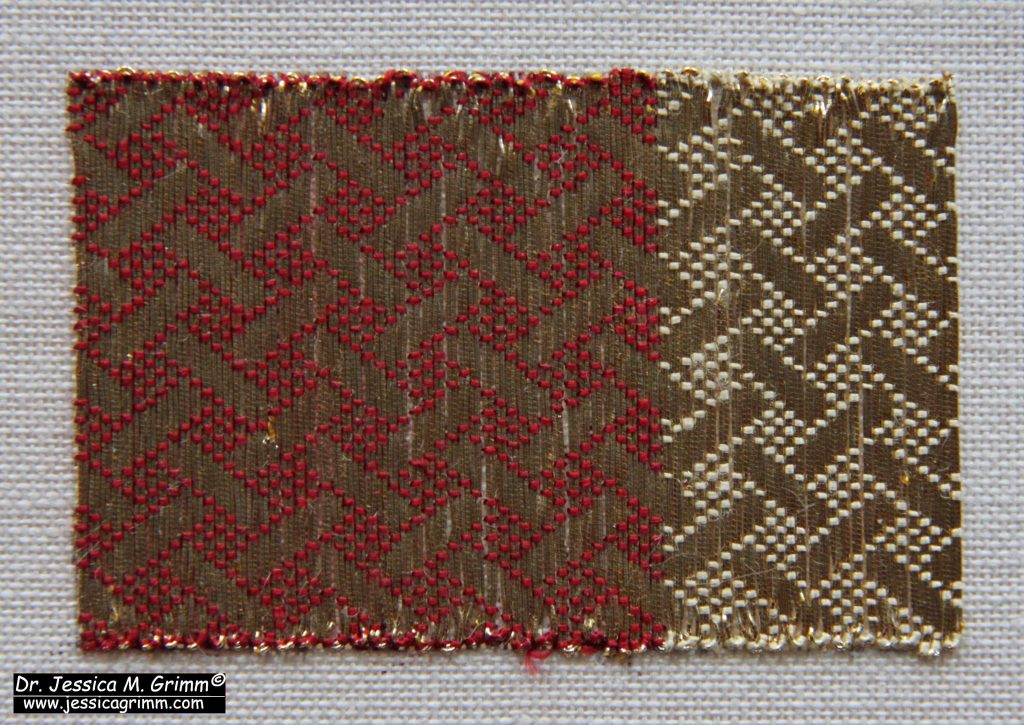
Lesson 4
In lesson 4, you will learn all about the four most popular diaper patterns in late-medieval goldwork embroidery.
We will apply madder dye to our fabric just as the embroiderers in the medieval period did. This makes the golden surface look even smoother. You will work an 4×6 cm sample on 48ct linen with fine red and yellow silk.
Lecture Video: 12 min.
Instruction Video: 21 min.
Hand-out: 19 pages
Time needed for practical work: c. 9 hours.

Lesson 5
In lesson 5, we will explore a readily recognisable detail from German medieval goldwork embroideries. These spirals, or suns, as they are called, were the pattern of choice to fill in the backgrounds of largely standardized scenes from Jesus’ life. You will work a 3,5×3.5 cm sample on 48ct linen with fine red silk.
Lecture Video: 8 min.
Instruction Video: 52 min.
Hand-out: 17 pages
Time needed for practical work: c. 1 hour
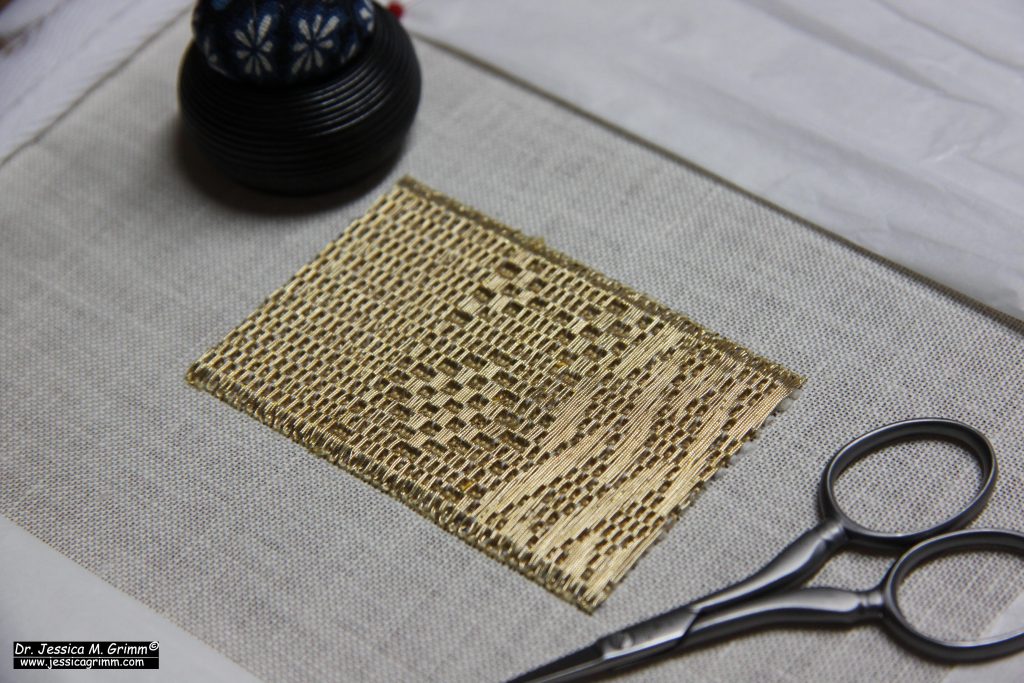
Lesson 6
Lesson 6 is devoted to different types of basket weave over padding. This goldwork technique is often seen as a kind of 3D frame surrounding the orphreys.
You will work a c. 7,5×5 cm sample with several patterns over linen string on 48ct linen.
Lecture Video: 6 min.
Instruction Video: 31 min.
Hand-out: 20 pages
Time needed for practical work: c. 11 hours
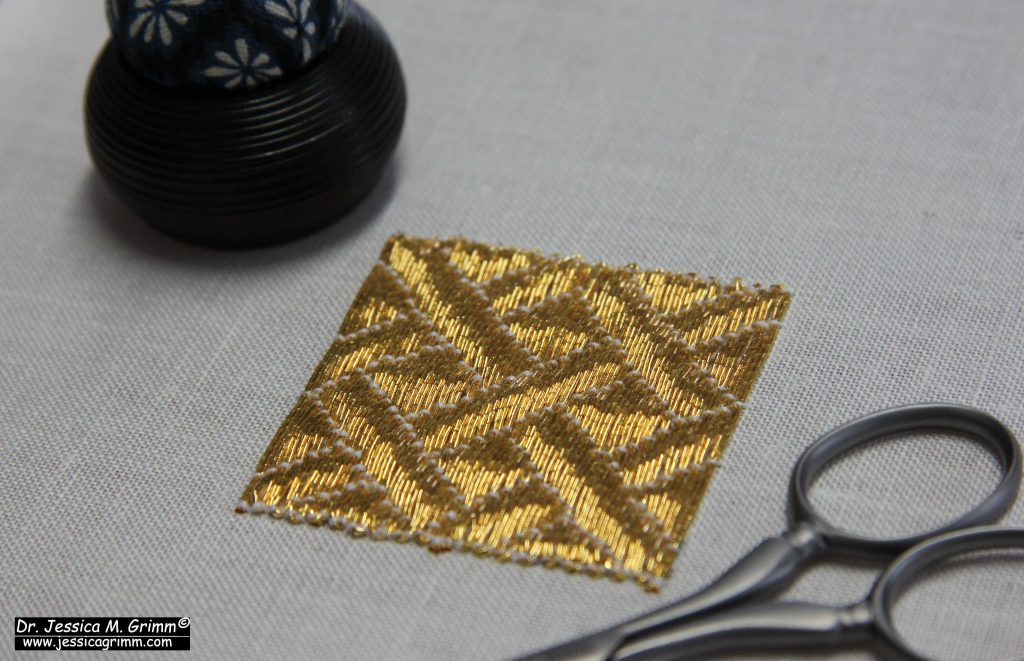
Lesson 7
In lesson 7, we will recreate a particularly elaborate diaper pattern worked over string padding. Not so much seen in orphreys from the Netherlands, but more common in Central and Southern Europe. Although the same popular basket weave diaper pattern is used, the effect is much more three-dimensional. And the hours involved in creating it are less than ‘simple’ flat diaper couching.
Your sample will be c. 5×5 cm and stitched on 48ct linen.
Lecture Video: 7 min.
Instruction Video: 15 min.
Hand-out: 22 pages
Time needed for the practical work: c. 4.5 hours.
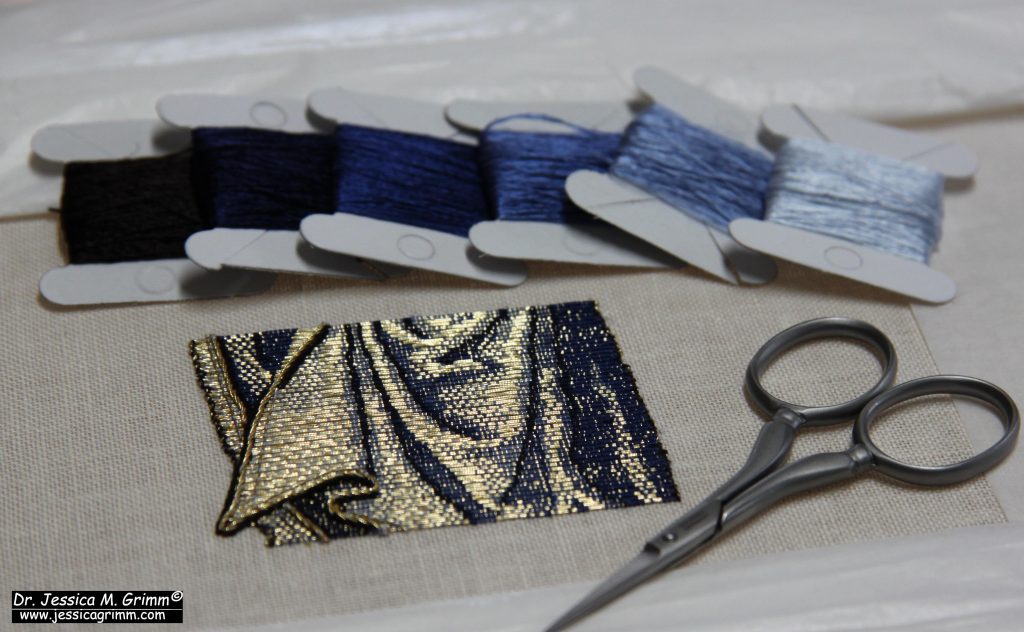
Lesson 8
For lesson 8, we will recreate part of Mary Magdalene’s dress in or nué. The original is featured on an orphrey made in AD 1530-1535 in a workshop in Amsterdam. In my opinion, this workshop produced some of the finest or nué figures that have survived to the present day. The drawings for the original patterns for these figures were made by Jacob Corneliszoon van Oostsanen c. 1475-1533).
With this last sample of medieval goldwork, we move away from a purely technical aspect of stitching and into the realm of creativity and art.
The sample measures c. 6.5×5 cm and is stitched on 48ct linen.
Lecture Video: 6 min.
Instruction Video: 1 hour 35 min.
Hand-out: 26 pages
Time needed for practical work: c. 19 hours.
Frequently Asked Questions
Medieval Goldwork Embroidery Course
What will you need?
A full kit with all the fabrics, spools of real gold thread, bundles of silk, needles and design transfer materials will be provided and is included in the course fee. In addition, you will need a c. 61 cm (length of webbing) slate frame (and the materials for setting it up: webbing, strong sewing thread, bracing needle and string). This type of slate frame can be had from the Royal School of Needlework, Ecclesiastical Sewing, Hand Embroidery Supplies and Jenny Adin-Christie Embroidery. All projects will fit on this size slate frame and there is no need to reframe in between projects. Furthermore: scissors, baby brush, ruler, kitchen towel and a small jar with a lid (think small marmelade glass). You will probably also need magnification. It is important that you can see all the stitching detail in the instruction videos. It is therefore recommended to watch them on a larger screen such as a computer, laptop or tablet.
What level of embroidery experience do you need?
Whilst it is not at all necessary to have any experience in goldwork embroidery, you do need to be beyond a total beginner in embroidery. Nobody but you can determine if this course is right for you. That’s why I have provided pictures of all samples with their sizes.
What else should I bring as a student?
As medieval goldwork embroidery is 99% ecclesiastical, you need to have an affinity with Christian iconography.
What will the teaching format be?
Each lesson will comprise of a PDF-download with all the historical and technical information on the particular technique explored, a recorded lecture with lots of detailed pictures of the original embroideries, and a video of me working the sample and giving tips. And as always, I am only an email away!
For how long will I have access to the course materials?
Each of the eight lessons comes with a downloadable PDF. These are yours for life. You will have access to the course videos for at least a year after the date of purchase. The videos cannot be downloaded.
What will it cost?
The fee for this in-depth hands-on and academic medieval goldwork embroidery course will be €875. We will work with REAL gold threads. This includes a full kit but excludes shipping fees. The full course fee needs to be paid upon registration. The course fee is non-refundable after your kit has shipped.
What are REAL gold threads?
Gilt goldthreads are usually made by gilding a copper-zinc base with a gold alloy (lower karat). The resulting foil is spun around an polyester core. The goldthreads in your kit are of higher quality and come much closer to medieval gold threads. Their base consists of pure silver and is gilded with 995 (or 24 karat) gold. This gilded silver foil is spun around a silken core. Your kit contains well over €300 worth of these lovely REAL gold threads!
What language is the course taught in?
The Medieval Goldwork Embroidery Course language is English. However, I can also answer questions in Dutch (my native language) and German.
Where do you ship to?
I ship world-wide.
When will the Medieval Goldwork Embroidery Course start?
You can register for the Medieval Goldwork Embroidery Course at the time announced at the top of this page. You cannot register nor pay in advance. Once the kits have sold out, you will need to wait for the next registration day. I will announce registration days in advance in my newsletter and on my blog. Once registered, you can start the Medieval Goldwork Embroidery Course as soon as you receive your kit. Your kit ships as soon as possible after you have registered and paid.
Can I pay by credit card?
Payment is handled through PayPal. You can use a credit card with them.
Questions?
I’m here to help! Email me at jessica(at)acupictrix.com. If the question is relevant to all prospective students, I will update this page accordingly.